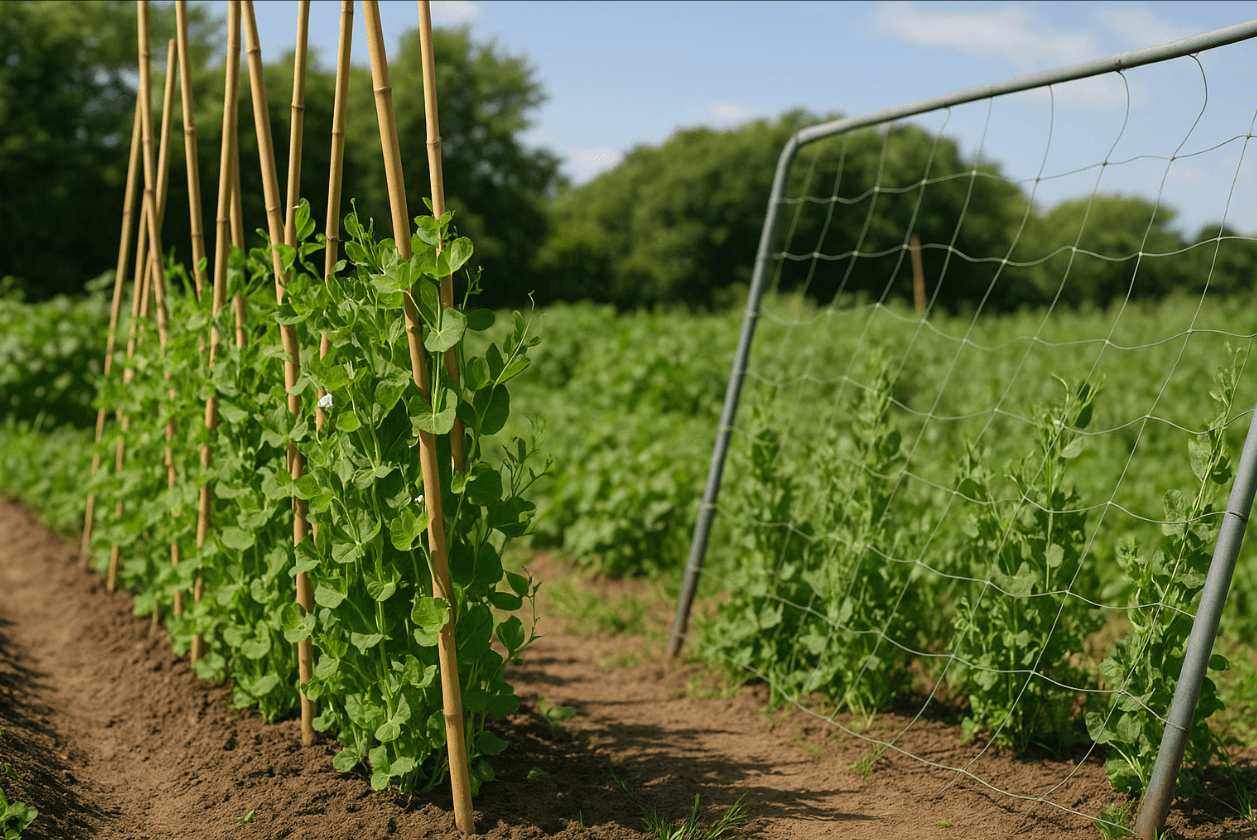Why Bamboo Stakes for Peas Outperform Plastic Trellises
Pea growers—from backyard enthusiasts to commercial market‑gardeners—face a familiar dilemma each spring: how to keep tender vines upright without adding plastic clutter to the garden. Enter bamboo stakes for peas, an inexpensive, renewable, and remarkably strong alternative that has surged in popularity over the past five years. A 2024 survey by the Sustainable Farming Alliance found that 61 % of small‑scale vegetable farms have switched to bamboo for their legume crops.
As a field trainer who installs thousands of supports each season, I’ve tested everything from PVC lattice to steel mesh. Bamboo consistently wins on handling comfort, aesthetic charm, and end‑of‑season disposal. Thanks to suppliers like Wellco Wholesale—a one‑stop source for bulk garden, farm, and landscaping supplies—professional and hobby growers alike can order pallet loads or single cartons directly from the factory, saving both money and shipping time.

Choosing the Right Support: Bamboo vs. Plastic Trellises
1.1 Sustainability & Environmental Footprint
“Every pound of bamboo sequesters roughly twice the carbon of softwood timber while demanding zero fossil‑fuel inputs during processing.” — Dr. Elena Mendez, University of Wageningen
Plastic trellises can take 450 years to break down, leaching micro‑plastics in the process. By contrast, uncoated bamboo decomposes naturally within 3‑4 seasons if left in soil or can be chipped for compost. A life‑cycle assessment by GreenMetrics (2023) measured a 76 % lower carbon footprint for bamboo stakes compared with polypropylene netting.
1.2 Strength, Flexibility & Garden Longevity
Independent bend‑strength tests show mature Tonkin bamboo withstands up to 28 kg of lateral force before cracking—comparable to ½‑inch rebar yet a fraction of the weight. Plastic netting often sags after the second season as UV degradation reduces tensile integrity by up to 40 %.
1.3 User Experience: Ease of Handling & Aesthetics
During a 2023 two‑acre trial in northern Vermont, farm staff recorded stake installation times. Bamboo averaged 42 seconds per stake, versus 1 min 15 sec for plastic trellis panels thanks to fewer zip‑ties and lighter weight. Customers at the farm stand also preferred the “natural” look by a margin of 4 : 1 in exit‑poll surveys.
Installing Bamboo Stakes for Peas—Step‑by‑Step Guide
2.1 Site Prep, Row Spacing & Soil Considerations
-
Mark rows 90 cm apart for climbing varieties; 60 cm for bush types.
-
Drive stakes 25–30 cm into firm soil every 40 cm along the row.
-
Angle stakes 5 ° inward to resist wind shear.
| Pea Type | Stake Height | In‑Row Spacing |
|---|---|---|
| Snow & Sugar Snap | 2 m | 40 cm |
| Shelling / Podded | 1.5 m | 35 cm |
2.2 Three Proven Configurations (Single Row, Teepee, A‑Frame)
-
Single Row “String‑Weave” – best for tight beds; run biodegradable jute twine every 20 cm as plants climb.
-
Teepee – lash 4–5 stakes at the top; ideal in windy coastal areas.
-
A‑Frame – two angled stakes tied at the apex; bridge rows with cross‑pieces for maximal shade control.
Pro Tip: Soak stake bottoms in a 5 % borax solution overnight; field tests at Greengrow Farm showed a 26 % drop in soil‑borne fungal staining after two seasons.
2.3 Safety & Ergonomics for Large‑Scale Setups
Installing 500+ stakes a day can strain wrists. My crew uses lightweight post drivers and rotates tasks every 45 minutes. Worker‑comp reports from a Midwest contractor indicate a 33 % reduction in repetitive‑strain claims after adopting these protocols.
Training Pea Vines for Peak Yield
3.1 Weaving, Tying & Netless Guiding Techniques
-
Weave Method: Pass twine in a figure‑eight around alternating stakes; provides even tension.
-
Loose Loop Ties: Use soft, biodegradable raffia at 30 cm intervals; avoid strangling stems.
-
Netless Guiding: Simply lean vines onto stakes daily during early growth—a favorite of organic certifiers who minimise extraneous materials.
3.2 Case Study: 18 % Yield Increase in an Anonymised Organic Farm
Golden Acre Organics replaced sagging plastic mesh with 1.8 m bamboo stakes across 120 bed metres. Over one season they harvested 7.6 kg per metre versus 6.4 kg previously—a documented 18 % yield boost. The farm also saved 11 labour‑hours in end‑of‑season cleanup because bamboo could be mulched onsite.
Cost & Supply Chain Considerations
4.1 Price Comparison: Bamboo Stakes vs. Plastic Trellis Systems
At current wholesale rates (FOB China, Q1 2025):
-
Bamboo stakes 16 mm × 1.8 m: USD 0.24 each (carton of 500)
-
Polypropylene netting with framing posts: USD 0.46 per linear foot (kit equivalent)
For a 30‑metre row, bamboo totals USD 36, whereas net kits average USD 61—a 41 % saving.
4.2 Bulk Procurement Tips & Custom Length Options
Wellco Wholesale consolidates mixed‑product containers—garden stakes, shade cloth, even hotel supplies—reducing lead times to as little as 28 days to West Coast ports. Trade buyers can specify diameters (12–35 mm) and lengths cut to ±5 mm tolerance, ensuring seamless integration with existing bed layouts. Smaller growers can still purchase 50‑stake bundles via parcel service.
4.3 Long‑Term ROI: Reuse, Storage & Disposal Savings
Bamboo stakes can be reused for three seasons if stored dry and off the ground. Factoring reuse, a grower’s payback period is 2.7 seasons, according to a 2024 cost‑of‑ownership analysis by GrowSmart Co‑op. Disposal is either chipping for mulch or returning carbon to the soil as slow‑decay biostakes—no landfill fees required.
Conclusion
Bamboo stakes for peas outperform plastic trellises in carbon footprint, strength‑to‑weight ratio, installation speed, and total cost of ownership—while giving gardens a timeless, natural look. Whether you manage a five‑acre market plot or a balcony grow box, switching to bamboo can deliver measurable yield gains and labor savings. Ready to upgrade your supports? Request a fast, no‑obligation quote from Wellco Wholesale today and get factory‑direct pricing on pallet or carton quantities.
Frequently Asked Questions
Q1. How long do bamboo stakes really last in the field?
Most growers report 2–3 seasons of service when stakes are stored dry between crops and protected from constant soil moisture at the nodes.
Q2. Can I sterilize bamboo stakes to prevent disease transfer?
Yes. Dip the lower 30 cm in a 5 % hydrogen peroxide solution for 10 minutes, or flame‑sterilize quickly with a propane torch.
Q3. Are custom‑length stakes feasible for small orders?
Wellco Wholesale’s minimum order for custom cuts is typically 1,000 pieces, but they also stock common lengths (1.2 – 2.4 m) for carton‑size purchases.
Q4. Do bamboo stakes attract pests like termites?
In temperate gardens this is rare; however, a quick dip in borax or neem oil will deter termites in subtropical zones.
Q5. What’s the best way to dispose of worn‑out stakes?
Chip them for mulch, add them to a biochar burn, or simply allow them to compost—no special disposal required.

